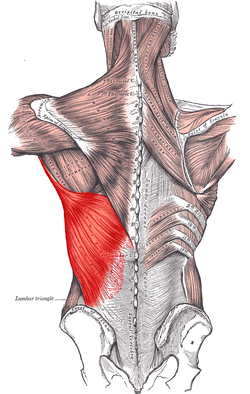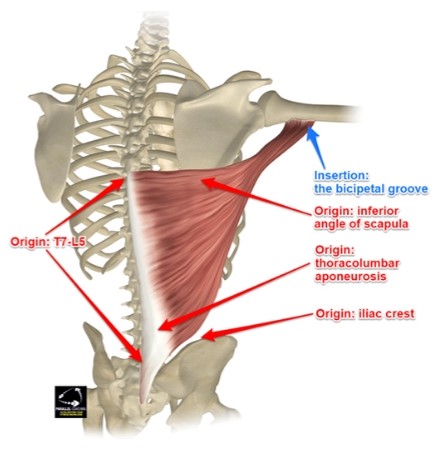
latissimus dorsi
By : Fahad Al-BakThe Naming: -
/la-TIS-i-mus DOOR-si/
The name means widest of the back (latissimus= wide) (dorsi = back).
The name means widest of the back (latissimus= wide) (dorsi = back).
General:-
It is a flat, large, fan shaped muscle located on the lower back; it runs from the middle of the back (where the trapezius ends usually) to the pelvic. It connects the trunk with the arm ( glenohumeral joint) and indirectly on the pectoral girdle (scapulothoracic joint).

Supply: -
-Blood supply comes from The Thoracodorsal Artery (a branch of the Subscapular Artery) and the dorsal branches of the Posterior Intercostal Arteries (branches of the Aorta).
- Nerve supply is from The Thoracodorsal Nerve C6, C7, C8.

Origin & Insertion
-Origin: Latissimus dorsi arises from the posterior layer of the thoracolumbar fascia, which attaches to the spinous processes of the lower six thoracic and all of the lumbar and sacral vertebrae, as well as to the intervening supraspinous and interspinous ligaments. That part arising from the lower six thoracic vertebrae is covered by trapezius. In addition to this vertebral attachment, latissimus dorsi arises from the posterior part of the outer lip of the iliac crest, most laterally by direct muscular slips. As the muscle fibers sweep upwards and laterally across the lower part of the thorax, they attach to the outer surfaces of the lower three or four ribs and via fascia to the inferior angle of the scapula.
-Insertion: the fibers converge as they pass to the humerus forming a thin flattened tendon, which winds around the lower border of teres major, and inserts into the floor of the inter tubercular groove of the humerus anterior to the tendon of teres major, being separated from it by a bursa. The effect of twisting of the muscle through 180 degree means that the anterior surface of the tendon is continuous with the posterior surface of the rest of the muscle. Consequently, the fibers with the lowest origin on the trunk gain the highest attachment on the humerus.
-Insertion: the fibers converge as they pass to the humerus forming a thin flattened tendon, which winds around the lower border of teres major, and inserts into the floor of the inter tubercular groove of the humerus anterior to the tendon of teres major, being separated from it by a bursa. The effect of twisting of the muscle through 180 degree means that the anterior surface of the tendon is continuous with the posterior surface of the rest of the muscle. Consequently, the fibers with the lowest origin on the trunk gain the highest attachment on the humerus.

Motion & Action: -
( Medially rotates the arm at the glenohumeral joint, Adducts the arm at the glenohumeral joint, Extends the arm at the glenohumeral joint )
The latissimus dorsi is a strong extensor of the flexed arm; however, if the humerus is fixed relative to the scapula it retracts the pectoral girdle. It is also a strong adductor and medial rotator of the humerus at the shoulder joint. In combination with the pectoralis major, the latissimus dorsi is a powerful adductor of the humerus, and plays a major role in downward rotation of the scapula in association with this movement.
It is also useful in restoring the upper limb from abduction superior to the shoulder; hence the latissimus dorsi is important in climbing. In conjunction with the pectoralis major, the latissimus dorsi raises the trunk to the arm, which occurs when performing chin-ups (hoisting oneself so the chin touches an overhead bar) or climbing a tree, for example. These movements are also used when chopping wood, paddling a canoe, and swimming (particularly during the crawl stroke).
The latissimus dorsi is a strong extensor of the flexed arm; however, if the humerus is fixed relative to the scapula it retracts the pectoral girdle. It is also a strong adductor and medial rotator of the humerus at the shoulder joint. In combination with the pectoralis major, the latissimus dorsi is a powerful adductor of the humerus, and plays a major role in downward rotation of the scapula in association with this movement.
It is also useful in restoring the upper limb from abduction superior to the shoulder; hence the latissimus dorsi is important in climbing. In conjunction with the pectoralis major, the latissimus dorsi raises the trunk to the arm, which occurs when performing chin-ups (hoisting oneself so the chin touches an overhead bar) or climbing a tree, for example. These movements are also used when chopping wood, paddling a canoe, and swimming (particularly during the crawl stroke).

In The Field Notes: -
-Testing the latissimus dorsi: To test the latissimus dorsi, the arm is abducted 90° and then adducted against resistance provided by the examiner. If the muscle is normal, the anterior border of the muscle can be seen and easily palpated in the posterior axillary fold
Clinical Note: -
Paralysis: Damages of the brachial plexus may paralyze the thoracodorsal nerve and thus affect the latissimus dorsi. In comparison, an isolated lesion of the nerve (e.g., by trauma) occurs very rarely. Clinical signs are the missing of a muscular relief at the back and the posterior axillary fold. In everyday life, the paralysis of the muscle may cause a light weakness in the shoulder, however usually the deficit is well compensated by the remaining shoulder musculature.

Relations: -
Relations: -
The latissimus dorsi is superficial except for a small
portion that is deep to the lower trapezius. The distal tendon of the latissimus dorsi runs parallel to the distal tendon of the teres major.
The teres major and the latissimus dorsi both attach onto the medial lip of the bicipital groove of the humerus.
On the medial lip, the latissimus dorsi attaches more anteriorly, with the teres major attaching directly posterior to it.
The latissimus dorsi’s attachments onto the ribs meet with and are approximately perpendicular to the external abdominal oblique’s attachments onto the ribs (inferior to the interdigitation of the serratus anterior with the
external abdominal oblique).
Deep to the latissimus dorsi in the lumbar region are the serratus posterior inferior, the most posterior attachments of the external and internal abdominal obliques, the erector spinae, and the quadratus lumborum.
From the posterior perspective, the serratus anterior is deep to the latissimus dorsi in the axillary region.
The latissimus dorsi is superficial except for a small
portion that is deep to the lower trapezius. The distal tendon of the latissimus dorsi runs parallel to the distal tendon of the teres major.
The teres major and the latissimus dorsi both attach onto the medial lip of the bicipital groove of the humerus.
On the medial lip, the latissimus dorsi attaches more anteriorly, with the teres major attaching directly posterior to it.
The latissimus dorsi’s attachments onto the ribs meet with and are approximately perpendicular to the external abdominal oblique’s attachments onto the ribs (inferior to the interdigitation of the serratus anterior with the
external abdominal oblique).
Deep to the latissimus dorsi in the lumbar region are the serratus posterior inferior, the most posterior attachments of the external and internal abdominal obliques, the erector spinae, and the quadratus lumborum.
From the posterior perspective, the serratus anterior is deep to the latissimus dorsi in the axillary region.
Sources: -
- Moore - Clinically Oriented Anatomy 7th Edition (701-703).
- Joseph E Muscolino - The Muscular System Manual: The Skeletal Muscles of the Human Body
Book 4t edition (128-130).
-Nigel Palastanga & Roger Soames Anatomy and Human Movement Structure and Function 6th edition (63).
- Joseph E Muscolino - The Muscular System Manual: The Skeletal Muscles of the Human Body
Book 4t edition (128-130).
-Nigel Palastanga & Roger Soames Anatomy and Human Movement Structure and Function 6th edition (63).
